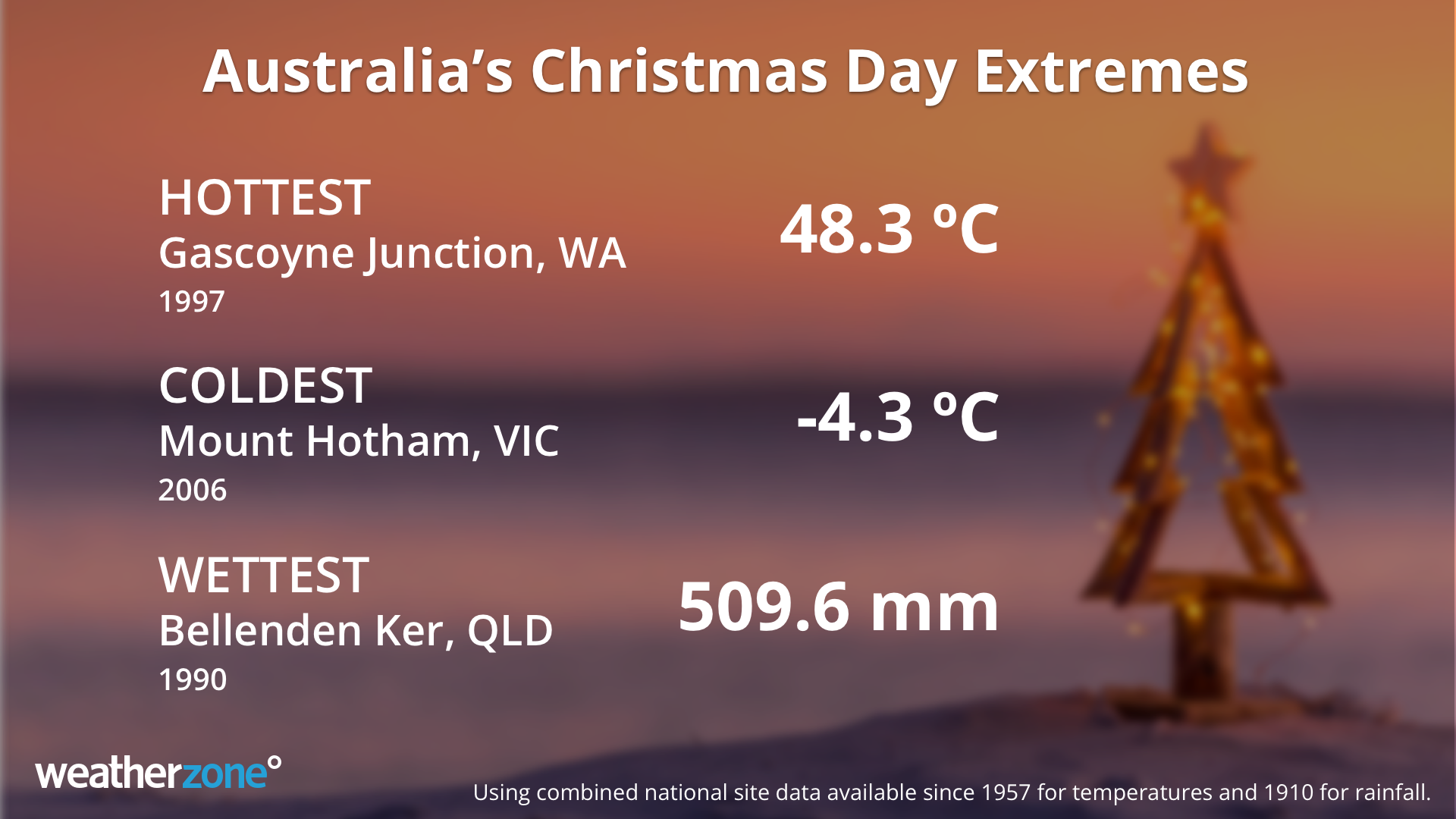Highs and lows of Christmas weather in Australia
Christmas Day is one of the most popular times of year for outdoor celebrations, but, as many know, sometimes the weather has other plans. Let's look at Australia's Christmas Day weather extremes over the years.

Hottest Christmas
Australia is no stranger to very hot temperatures, and with Christmas right in the middle of the hottest time of year, it's no surprise that there have been some scorchers over the years.
Unsurprisingly, Australia's hottest Christmas Day occurred in Western Australia. Gascoyne Junction holds that honour, as it reached a scorching 48.3C back in 1997.
Birdsville, Queensland, has had some Christmas wishes answered over the years, with not one but two extreme heatwaves ending on Christmas Day. Both in 1972 and 2019, Birdsville reached above 49°C on Christmas Eve, followed by an above 30-degree night with a (slightly) cooler change arriving on Christmas Day bringing some relief from the heatwave.
In the capital cities, Adelaide, Melbourne, and Perth have each had multiple Christmases where the mercury has exceeded 40°C. Perth has had the most with five Christmas Days above 40°C, the hottest of which was 42.8°C in 2021. Adelaide is close behind with four 40-degree Christmases while Melbourne has had two. All the remaining capital cities have each had at least one Christmas hotter than 35°C.

Image: Maximum temperatures for Christmas Day, 2021
Coldest Christmas
Being summer, Australia is not really known for its White Christmases, but there have been a few over the years.
By far the standout is Mount Hotham, Victoria, in 2006. It dropped to a frigid –4.3°C during the morning, surely making Santa’s reindeer feel right at home, and making it Australia’s coldest Christmas temperature. That same day, the maximum temperature was only –0.8°C, the second coldest temperature at any site recorded during an Australian summer day.

Image: Temperature anomalies on Christmas Day, 2006. Source: NOAA
Single digit Christmas mornings are common for some of Australia’s highest observation sites, like Thredbo, Mt Hotham and kunanyi/Mt Wellington, but have also occurred at several capital cities over the years. Adelaide, Canberra, Hobart, and Melbourne have all seen Christmas mornings below 10°C, with the coldest being in Hobart in 1972, falling to 4.1°C. Incidentally, this was also Hobart’s wettest Christmas day with 30mm falling.
Wettest Christmas
While dry Christmases are the norm in southern parts of Australia, Christmas occurs squarely in the middle of the wet season for northern and eastern Australia, meaning there have been some colossal Christmas rainfall totals over the years.
The wettest Christmas Day was at Australia’s wettest site: Bellenden Ker Top Station, Queensland. In 1990, a mammoth 509.6mm fell in the 24 hours to 9am Christmas Day. This was in the lead up to the landfall of Severe Tropical Cyclone Joy, which was responsible for one of the worst floods on record for parts of Queensland.
Daily rainfalls of over 300mm have occurred 13 times in Australia over the past 114 Christmas Days, with seven of them occurring in 2010 during the landfall of Tropical Cyclone Tasha. Once again, Bellenden Ker Top Station topped the list that year with an estimated 484.2mm.
Often the wettest location on Christmas Day in any given year will exceed 80mm, but two years stand out as being much drier than others. The wettest location in all of Australia in 1963 was Hillgrove, NSW, which recorded just 36.1mm, with the highest rainfall in 1938 occurring in Bamboo Creek, WA, with 39.4mm. That makes these two years easily the driest overall Christmases on record for Australia.
For the capital cities, Darwin’s wettest Christmas stands well above the rest. 277mm fell over Darwin in the 24 hours to 9am Christmas Day in 1974 during the landfall of Severe Tropical Cyclone Tracy. Second to that ranks Brisbane (67.3mm in 1873) and Sydney (65.8mm in 1870), with all other capital cities recording between 24 and 30mm of rainfall on their wettest Christmas Days.

*Note: Hottest, coldest and wettest days were determined using combined national site data available since 1957 for temperatures and 1910 for rainfall.
What is forecast for Christmas Day 2024?
Overall, this Christmas is shaping up to be a dry one across most of Australia. The only areas of significant precipitation are expected to be in northern Australia, most notably around Broome, with only small amounts expected over southern parts of WA and western Tasmania.

Image: ECMWF forecast 24hr rainfall for Christmas Day, 2024.
This Christmas Day will be largely characterised by the heat peaking over South Australia, with temperatures in the mid-forties. This heat will track east to peak on Boxing Day over the southern and eastern states. Otherwise, a vast majority of the country is looking at excellent conditions for any outdoor celebrations.

Image: ECMWF forecast maximum temperature for Christmas Day, 2024.
Whatever you are up to on December 25th, we hope you have a great Christmas from all of us here at Weatherzone.